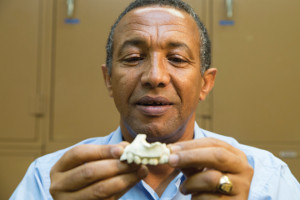launch
OVERLAPPING WITH LUCY
 photo: Laura Dempsey
photo: Laura DempseyYohannes Haile-Selassie holds a cast of an upper jaw fossil believed to be from an early human ancestor.
On the last day of one of archaeologist Yohannes Haile-Selassie's seasonal digs in northern Ethiopia, a crew member spotted a bone jutting from the silty clay ground. Within an hour of digging, dusting, sieving and culling, the team found a complete upper jaw—and put off going home. The find revealed a previously unknown early human ancestor alive more than 3 million years ago, upending a conventional idea that humans evolved one species at a time.
After spending more than three years analyzing the find, an international team that included Haile-Selassie, PhD, curator of physical anthropology at the Cleveland Museum of Natural History and an adjunct professor of anthropology, anatomy, and cognitive sciences at Case Western Reserve, and a university faculty colleague, Beverly Saylor, PhD, announced the discovery of a new early human ancestor species in the journal Nature in May.
"Human evolution is complex in ways we are still trying to understand," Haile-Selassie said. "More than one species of many animals and plants live at the same place and time. Why not humans?"
Saylor, associate professor of stratigraphy and sedimentology, is part of a team that dated the new fossil species—Australopithecus deyiremeda—to the same time period and region as "Lucy," the well-known early human fossil discovered in 1974. "The soils, rocks and volcanic layers at the site all tell us the same thing: These fossils are between 3.3 [million] and 3.5 million years old," Saylor said.
An earlier Museum of Natural History team with Case Western Reserve ties discovered Lucy. Haile-Selassie, meanwhile, has participated in other notable early human fossil discoveries in his home country of Ethiopia. They include the previously unknown 4.4 million-year old "Ardi" (Ardipithecus ramidus) species; the 3.6 million-year old "Big Man," one of only two known adult partial skeletons of Lucy's species (Australopithecus afarensis); and a 3.4 million year-old grasping foot from an unknown early human species that provides clues about the transition from tree- to land-based lifestyles.






